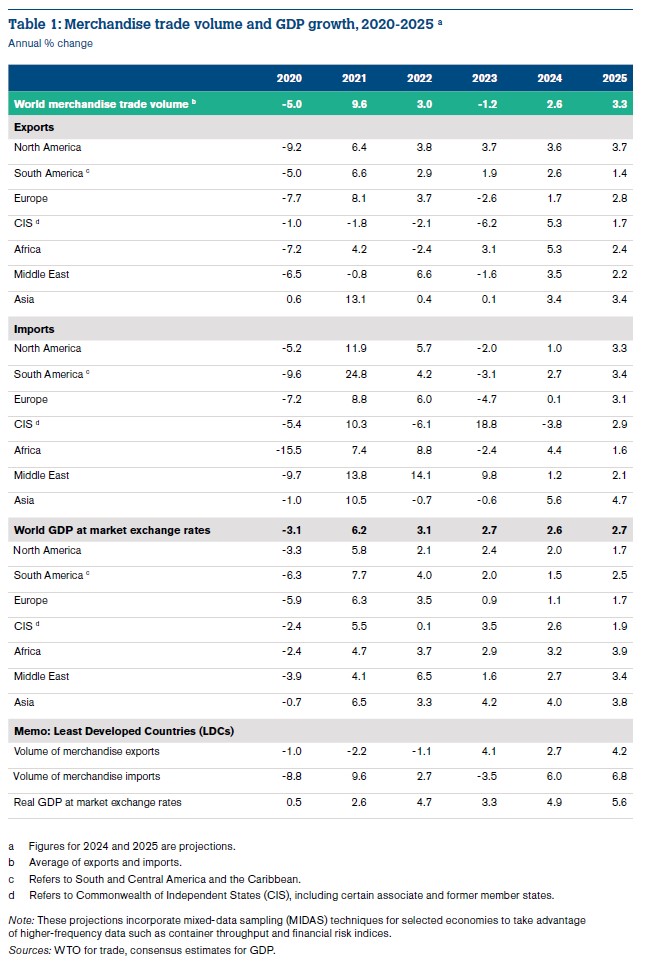
WTO forecasts rebound in global trade but warns of downside risks

Global goods trade is expected to pick up gradually this year following a contraction in 2023 that was driven by the lingering effects of high energy prices and inflation, WTO economists said in a new forecast on 10 April. The volume of world merchandise trade should increase by 2.6% in 2024 and 3.3% in 2025 after falling 1.2% in 2023. However, regional conflicts, geopolitical tensions and economic policy uncertainty pose substantial downside risks to the forecast.
In the latest “Global Trade Outlook and Statistics” report, WTO economists note that inflationary pressures are expected to abate this year, allowing real incomes to grow again — particularly in advanced economies — thus providing a boost to the consumption of manufactured goods. A recovery of demand for tradable goods in 2024 is already evident, with indices of new export orders pointing to improving conditions for trade at the start of the year.

WTO Director-General Ngozi Okonjo-Iweala said: “We are making progress towards global trade recovery, thanks to resilient supply chains and a solid multilateral trading framework — which are vital for improving livelihoods and welfare. It’s imperative that we mitigate risks like geopolitical strife and trade fragmentation to maintain economic growth and stability.”
High energy prices and inflation continued to weigh heavily on demand for manufactured goods, resulting in a 1.2% decline in world merchandise trade volume for 2023. The decline was larger in value terms, with merchandise exports down 5% to US$ 24.01 trillion. Trade developments on the services side were more upbeat, with commercial services exports up 9% to US$ 7.54 trillion, partly offsetting the decline in goods trade.
Import volumes were down in most regions but especially in Europe, where they fell sharply. The main exceptions were large fuel-exporting economies, whose imports were sustained by strong export revenues as energy prices remained high by historical standards. World trade remained well above its pre-pandemic level throughout 2023. By the fourth quarter it was nearly unchanged compared to the same period in the 2022 (+0.1%) and had only risen slightly compared to the same period in 2021 (+0.5%).
The report further estimates global GDP growth at market exchange rates will remain mostly stable over the next two years at 2.6% in 2024 and 2.7% in 2025, after slowing to 2.7% in 2023 from 3.1% in 2022. The contrast between the steady growth of real GDP and the slowdown in real merchandise trade volume is linked to inflationary pressures, which had a downward effect on consumption of trade-intensive goods, particularly in Europe and North America

Trade in services
World commercial services trade grew 9% in 2023 despite a decline in freight transport, thanks to recovering international travel and surging digitally delivered services. In 2024, sports events to be held in Europe in the summer, as well as the easing of visa requirements by various countries, are expected to boost tourism and passenger transport.
Global exports of digitally delivered services soared to US$ 4.25 trillion in 2023, up 9.0% year-on-year, and accounted for 13.8% of world exports of goods and services. In 2023, the value of these services — traded over borders through computer networks and encompassing everything from professional and management services to streaming of music and videos, online gaming, and remote education — surpassed pre-pandemic levels by over 50%. In Europe and Asia, which hold a global market share of 52.4% and 23.8% respectively, exports rose by 11% and 9%. Growth accelerated in Africa (13%) and in South and Central America and the Caribbean (11%), exceeding the global average. The two regions, which formed only 0.9% and 1.6% of global exports in 2023, are on the path to take advantage of digitally delivered services trade.
The WTO has released a new dataset on trade in services by mode of supply as in the WTO General Agreement on Trade in Services (GATS). It provides valuable insights on how services trade has modified over the years, including the impact of digitalization and of the COVID-19 pandemic.
This dataset as well as the latest estimates on digitally delivered services trade and service trade in general can be visualized and downloaded in the Global Services Trade Data Hub. The newly launched Global Services Trade Data Hub gives access to comprehensive WTO services trade data. It provides visualizations and customizable features catering to the diverse needs of trade negotiators, analysts, researchers, and decision-makers, to derive insights.



